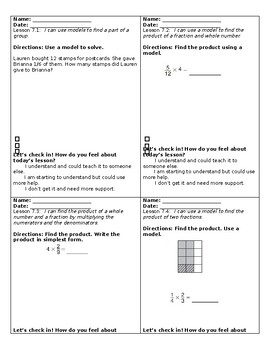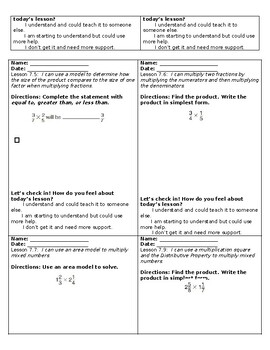Exit Tickets GO Math - Chapter 7 Multiplying Fractions - Grade 5
Miss Lombardi and Her Lucky Learners
1 Follower
Grade Levels
5th
Subjects
Resource Type
Standards
CCSS5.NF.B.4a
CCSS5.NF.B.4b
CCSS5.NF.B.5a
CCSS5.NF.B.5b
CCSS5.NF.B.6
Formats Included
- Word Document File
Miss Lombardi and Her Lucky Learners
1 Follower
Description
Do you need a quick way to assess your student's learning after a lesson in Go Math? These exit tickets are created in a Microsoft Word Document. They are made to be printed one-sided and then cut out and made into a mini booklet. Each exit ticket includes the learning objective, the directions, an equation or word problem to solve, and a "mood meter" (How well did they understand the lesson today?) for your students to complete on how they feel about the lesson. An easy way to collect data!
Total Pages
Answer Key
N/A
Teaching Duration
N/A
Report this resource to TPT
Reported resources will be reviewed by our team. Report this resource to let us know if this resource violates TPT’s content guidelines.
Standards
to see state-specific standards (only available in the US).
CCSS5.NF.B.4a
Interpret the product (𝘢/𝘣) × 𝘲 as a parts of a partition of 𝘲 into 𝘣 equal parts; equivalently, as the result of a sequence of operations 𝘢 × 𝘲 ÷ 𝘣. For example, use a visual fraction model to show (2/3) × 4 = 8/3, and create a story context for this equation. Do the same with (2/3) × (4/5) = 8/15. (In general, (𝘢/𝘣) × (𝘤/𝘥) = 𝘢𝘤/𝘣𝘥.)
CCSS5.NF.B.4b
Find the area of a rectangle with fractional side lengths by tiling it with unit squares of the appropriate unit fraction side lengths, and show that the area is the same as would be found by multiplying the side lengths. Multiply fractional side lengths to find areas of rectangles, and represent fraction products as rectangular areas.
CCSS5.NF.B.5a
Comparing the size of a product to the size of one factor on the basis of the size of the other factor, without performing the indicated multiplication.
CCSS5.NF.B.5b
Explaining why multiplying a given number by a fraction greater than 1 results in a product greater than the given number (recognizing multiplication by whole numbers greater than 1 as a familiar case); explaining why multiplying a given number by a fraction less than 1 results in a product smaller than the given number; and relating the principle of fraction equivalence 𝘢/𝘣 = (𝘯×𝘢)/(𝘯×𝘣) to the effect of multiplying 𝘢/𝘣 by 1.
CCSS5.NF.B.6
Solve real world problems involving multiplication of fractions and mixed numbers, e.g., by using visual fraction models or equations to represent the problem.




